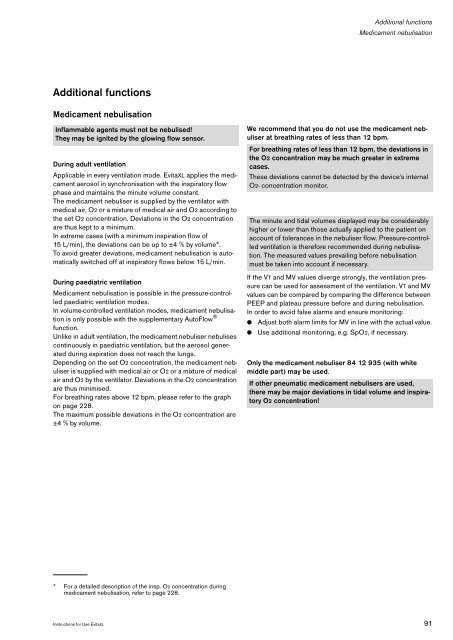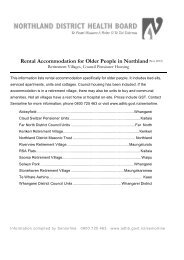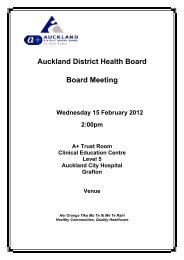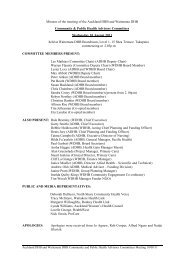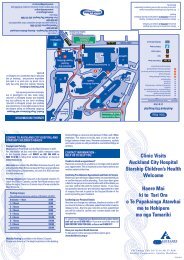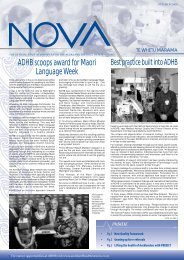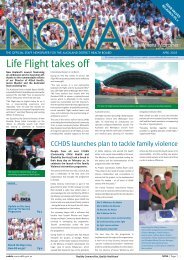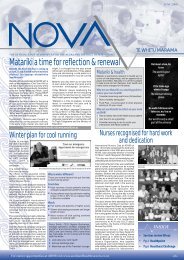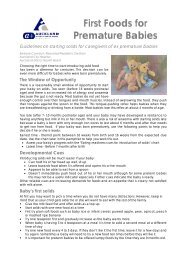EvitaXL
EvitaXL
EvitaXL
Create successful ePaper yourself
Turn your PDF publications into a flip-book with our unique Google optimized e-Paper software.
Additional functions<br />
Medicament nebulisation<br />
Inflammable agents must not be nebulised!<br />
They may be ignited by the glowing flow sensor.<br />
During adult ventilation<br />
Applicable in every ventilation mode. <strong>EvitaXL</strong> applies the medicament<br />
aerosol in synchronisation with the inspiratory flow<br />
phase and maintains the minute volume constant.<br />
The medicament nebuliser is supplied by the ventilator with<br />
medical air, O2 or a mixture of medical air and O2 according to<br />
the set O2 concentration. Deviations in the O2 concentration<br />
are thus kept to a minimum.<br />
In extreme cases (with a minimum inspiration flow of<br />
15 L/min), the deviations can be up to ±4 % by volume*.<br />
To avoid greater deviations, medicament nebulisation is automatically<br />
switched off at inspiratory flows below 15 L/min.<br />
During paediatric ventilation<br />
Medicament nebulisation is possible in the pressure-controlled<br />
paediatric ventilation modes.<br />
In volume-controlled ventilation modes, medicament nebulisation<br />
is only possible with the supplementary AutoFlow ®<br />
function.<br />
Unlike in adult ventilation, the medicament nebuliser nebulises<br />
continuously in paediatric ventilation, but the aerosol generated<br />
during expiration does not reach the lungs.<br />
Depending on the set O2 concentration, the medicament nebuliser<br />
is supplied with medical air or O2 or a mixture of medical<br />
air and O2 by the ventilator. Deviations in the O2 concentration<br />
are thus minimised.<br />
For breathing rates above 12 bpm, please refer to the graph<br />
on page 228.<br />
The maximum possible deviations in the O2 concentration are<br />
±4 % by volume.<br />
* For a detailed description of the insp. O2 concentration during<br />
medicament nebulisation, refer to page 228.<br />
Additional functions<br />
Medicament nebulisation<br />
We recommend that you do not use the medicament nebuliser<br />
at breathing rates of less than 12 bpm.<br />
For breathing rates of less than 12 bpm, the deviations in<br />
the O2 concentration may be much greater in extreme<br />
cases.<br />
These deviations cannot be detected by the device's internal<br />
O2- concentration monitor.<br />
The minute and tidal volumes displayed may be considerably<br />
higher or lower than those actually applied to the patient on<br />
account of tolerances in the nebuliser flow. Pressure-controlled<br />
ventilation is therefore recommended during nebulisation.<br />
The measured values prevailing before nebulisation<br />
must be taken into account if necessary.<br />
If the VT and MV values diverge strongly, the ventilation pressure<br />
can be used for assessment of the ventilation. VT and MV<br />
values can be compared by comparing the difference between<br />
PEEP and plateau pressure before and during nebulisation.<br />
In order to avoid false alarms and ensure monitoring:<br />
● Adjust both alarm limits for MV in line with the actual value.<br />
● Use additional monitoring, e.g. SpO2, if necessary.<br />
Only the medicament nebuliser 84 12 935 (with white<br />
middle part) may be used.<br />
If other pneumatic medicament nebulisers are used,<br />
there may be major deviations in tidal volume and inspiratory<br />
O2 concentration!<br />
Instructions for Use <strong>EvitaXL</strong> 91


